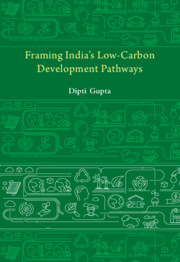Book contents
- Frontmatter
- Contents
- List of figures
- List of tables
- Prologue
- Acknowledgements
- List of abbreviations
- 1 Achieving Net Zero: A Wicked Problem for India
- 2 Themes for Exploring Low-Carbon Pathways
- 3 Building a Hybrid Dataset for Modelling Low-Carbon Pathway
- 4 Bottom-Up Approach and Technology Details
- 5 Macroeconomic Framing of Energy Systems in India Using Simulations
- 6 Top-Down Approach: Multi-Sector Economy-Wide Model
- 7 Scenario Construction and Pathways Analysis
- 8 Sectoral Case Study: Application of Hybrid Approach to Economy-Wide Analysis
- 9 Sectoral Case Study: Application of the Hybrid Modelling Approach to the Transport Sector
- 10 Conclusion: Other Applications, Policy Insights, and Road Ahead
- Index
7 - Scenario Construction and Pathways Analysis
Published online by Cambridge University Press: 15 July 2025
- Frontmatter
- Contents
- List of figures
- List of tables
- Prologue
- Acknowledgements
- List of abbreviations
- 1 Achieving Net Zero: A Wicked Problem for India
- 2 Themes for Exploring Low-Carbon Pathways
- 3 Building a Hybrid Dataset for Modelling Low-Carbon Pathway
- 4 Bottom-Up Approach and Technology Details
- 5 Macroeconomic Framing of Energy Systems in India Using Simulations
- 6 Top-Down Approach: Multi-Sector Economy-Wide Model
- 7 Scenario Construction and Pathways Analysis
- 8 Sectoral Case Study: Application of Hybrid Approach to Economy-Wide Analysis
- 9 Sectoral Case Study: Application of the Hybrid Modelling Approach to the Transport Sector
- 10 Conclusion: Other Applications, Policy Insights, and Road Ahead
- Index
Summary
Introduction
A scenario is a narrative that outlines a potential future that helps identify significant events, main actors, and drivers and their motivations and provides insight into the functioning of the world. Building and utilizing scenarios can aid individuals in addressing potential challenges that may be present in future. Scenarios are intuitive, analytical structures that vividly depict potential futures but do not provide consensus or predictions. They describe context and changes but do not dictate user responses. Scenarios serve as a strategic tool for analysing potential policy implications and responses to events, thus providing a common language for discussing current events and exploring future uncertainties for successful decision-making (Shell International, 2008).
Scenarios are compelling, yet challenging, narratives that outline the future, addressing uncertainties and not providing forecasts, projections, or recommendations. Building scenarios involves asking questions, providing answers, and offering guidance for action, aiming to broaden perspectives and highlight key issues. It provides insight into uncertainties and potential consequences, promoting informed and rational decision-making by highlighting potential outcomes of current and future actions. Scenarios explore real-world issues like system dynamics, structural changes, policy choices, technological evolution, and macroeconomic patterns, reflecting the fact that the future situations are influenced by human
actions. However, the age-old drive to contemplate collective possibilities and draw lessons for today remains (Raskin, 2005).
Scenario as solutions
Scenario planning is an imaginative process that involves hypothetically imagining the future, which is considered an innate human activity, allowing us to think about it and plan for it (Hughes, 2009). Scenario building can address real-world problems in various ways, as shown in Figure 7.1.
Information
- Type
- Chapter
- Information
- Framing India's Low Carbon Development Pathways , pp. 147 - 182Publisher: Cambridge University PressPrint publication year: 2025
